Suitability Evaluation of Ecological Restoration Relying on Water Resources in an Agro-Pastoral Transition Zone: A Case Study of Zhangbei, Zhangjiakou, Northern China
Abstract
1. Introduction
2. Materials and Methods
2.1. The Study Area
2.2. Data Sources
2.2.1. Basic Data
2.2.2. High-Resolution Environmental Geological Survey of Agro-Pastoral Transition Zone
2.3. Evaluation of Ecosystem Service Function Importance
2.3.1. Evaluation of Water Conservation Function Importance
2.3.2. Evaluation of Soil and Water Conservation Function Importance
2.3.3. Evaluation of Biodiversity Maintenance Function Importance
2.3.4. Evaluation of Windbreak and Sand Fixation Function Importance
2.4. Evaluation of Ecological Sensitivity
2.5. Evaluation of Ecological Protection Importance
2.6. Principles for Naming Ecological Restoration Zones
3. Results and Discussion
3.1. Evaluation Results of Ecological Service Function Importance
3.1.1. Evaluation Results of Water Conservation Function Importance
3.1.2. Evaluation Results of Soil and Water Conservation Function Importance
3.1.3. Evaluation Results of Biodiversity Maintenance Function Importance
3.1.4. Evaluation Results of Windbreak and Sand Fixation Function Importance
3.2. Evaluation Results of Ecological Sensitivity
3.3. Evaluation Results of Ecological Protection Importance
3.4. Results of Ecological Restoration Zoning
- Agro-forest–wetland ecological restoration and soil erosion control zone
- Agro-forest–wetland ecological restoration and water conservation zone
- Forest–grassland soil erosion and soil–water conservation zone
- Mountain forest conservation and biodiversity maintenance zone
4. Conclusions
- The critically important zones of water conservation function are mainly distributed in southern Zhangbei and surround Huanggainao Lake in the north. The critically important zones of soil and water conservation function are mainly distributed in regions with abundant forest and grassland coverage. The critically important zones of water conservation function are mainly distributed in southern Zhangbei and surround the Huanggainao Lake in the north. The critically important zones of soil and water conservation are distributed in regions with abundant forest and grassland coverage. The critically important zones of biodiversity maintenance functions are mainly distributed around Xiaoertai Lake and its vicinity. The critically important zones of windbreak and sand fixation function are ubiquitously distributed throughout the country. The highly sensitive zones of ecological sensitivity, covering 4.15% of this area, are mainly distributed around wetland such as Anguli Nao. The important and generally important zones of ecological protection exhibit a distinct north–south spatial gradient. The critically important conservation zones with only 333.04 km2 (7.71%) predominantly overlap with wetland systems.
- According to the evaluation of ecosystem service importance, ecological sensitivity importance, and ecological protection importance in Zhangbei, the study area is divided into four ecological restoration zones: agro-forest–wetland ecological restoration and soil erosion control zone, agro-forest–wetland ecological restoration and water conservation zone, forest–grassland soil erosion and soil–water conservation zone, and mountain forest conservation and biodiversity maintenance zone. Each zone was assigned tailored restoration measures, such as afforestation, wetland rehabilitation, and erosion control infrastructure, to address region-specific ecological challenges.
- Compared to conventional approaches, this study prioritizes dominant ecological functions as the cornerstone of ecological restoration zoning in Zhangbei. By anchoring both the conceptual framework and practical implementation in these functions, the methodology clarifies pathways for integrated territorial space management and establishes a scientifically grounded basis for local ecological restoration and spatial governance.
- Next, research will develop advanced multi-source data fusion to enhance DEM/NDVI spatiotemporal resolution, improve real-time vegetation/soil monitoring, conduct multi-scale evaluations and ecological simulations analyzing spatial heterogeneity impacts, and establish ecology–economy models to evaluate synergies between conservation and agricultural/energy development.
Author Contributions
Funding
Data Availability Statement
Conflicts of Interest
References
- Fu, B.J. Trends and priority areas in ecosystem research of China. Geogr. Res. 2010, 29, 383–396. [Google Scholar]
- Lovell, S.T.; Taylor, J.R. Supplying urban ecosystem services through multifunctional green infrastructure in the United States. Landsc. Ecol. 2013, 28, 1447–1463. [Google Scholar] [CrossRef]
- Yang, S.; An, Y.; Wang, P.; Ma, L.; Hu, F.; Sun, Q. Study of ecological red-line zones in Guizhou Chishui River basin. Resour. Environ. Yangtze Basin 2015, 24, 1405–1411. [Google Scholar]
- Hou, P.; Yang, M.; Zhai, J.; Liu, X.; Wan, H.; Li, J.; Cai, M.; Liu, H. Discussion about natural reserve and construction of national ecological security pattern. Geogr. Res. 2017, 36, 420–428. [Google Scholar]
- Li, S.; Zhai, H. The comparison study on forestry ecological projects in the world. Acta Ecol. Sin. 2002, 22, 1976–1982. [Google Scholar]
- Ehrenfeld, J.G. Defining the limits of restoration: The need for realistic goals. Restor. Ecol. 2000, 8, 2–9. [Google Scholar] [CrossRef]
- Herbertson, A.J. The major natural regions: An essay in systematic geography. Geogr. J. 1905, 25, 300. [Google Scholar] [CrossRef]
- Palmer, M.A.; Bernhardt, E.S.; Allan, J.D.; Lake, P.S.; Alexander, G.; Brooks, S.; Carr, J.; Clayton, S.; Dahm, C.N.; Follstad Shah, J.; et al. Standards for ecologically successful river restoration. J. Appl. Ecol. 2005, 42, 208–217. [Google Scholar] [CrossRef]
- Mace, G.M. Whose conservation? Science 2014, 345, 1558–1560. [Google Scholar] [CrossRef]
- Geldmann, J.; Joppa, L.N.; Burgess, N.D. Mapping change in human pressure globally on land and within protected areas. Conserv. Biol. 2014, 28, 1604–1616. [Google Scholar] [CrossRef]
- Higgs, E.; Harris, J.; Murphy, S.; Bowers, K.; Hobbs, R.; Jenkins, W.; Kidwell, J.; Lopoukhine, N.; Sollereder, B.; Suding, K.; et al. On principles and standards in ecological restoration. Restor. Ecol. 2018, 26, 399–403. [Google Scholar] [CrossRef]
- Madrona Conservation Initiative. Prioritizing Aquatic Conservation and Restoration in the Pacific Northwest (Techniacal Report/EB/OL). 2022. Available online: https://www.madrona.org/reports/aquatic-conservation-pacific-2022 (accessed on 3 May 2025).
- Lathrop, R.B. Applying GIS and landscape ecological principles to evaluate land conseration alereratives. Landsc. Urban Plan. 1988, 41, 27–41. [Google Scholar] [CrossRef]
- Stoorvogel, J. Intergration of computer-based models and GIS tools to evaluate altermative land-use scenatries as part of an agricultural systems analysis. Agric. Syst. 1995, 49, 353–367. [Google Scholar] [CrossRef]
- Ayanu, Y.Z.; Conrad, C.; Nauss, T.; Wegmann, M.; Koellner, T. Quantifying and mapping ecosystem services supplies and demands: A review of remote sensing applications. Environ. Sci. Technol. 2012, 46, 8529–8541. [Google Scholar] [CrossRef] [PubMed]
- Wang, X.; Zhang, X.; Mu, X.; Zhu, Z. An analysis on the compilation method of ecological restoration planning for territorial space. Environ. Prot. 2019, 47, 36–38. [Google Scholar]
- Fang, C.; Wang, Z.; Liu, H. Exploration on the theoretical basis and evaluation plan of beautiful China construction. Acta Geogr. Sin. 2019, 74, 619–632. [Google Scholar]
- Wang, J.; Ying, L.; Zhong, L. Thinking for the transformation of land consolidation and ecological restoration in the new era. J. Nat. Resour. 2020, 35, 26–36. [Google Scholar]
- Yi, X.; Bai, C.; Liang, L.; Zhao, Z.; Song, W.; Zhang, Y. The evolution and frontier development of land ecological restoration research. J. Nat. Resour. 2020, 35, 37–52. [Google Scholar]
- Lv, J.X.; Li, Q. Research on the policy system and implement path of territorial ecological restoration. J. Hebei Acad. Sci. 2023, 40, 62–69. [Google Scholar]
- Liu, Y.; Shi, P.; Liu, M.; Xu, K.; Zhang, N.; Jiang, P.; Wang, W.; Jiang, Y. Spatial pattern of water conservation function and ecological management suggestion in the catchment area of the upper reaches of Qinhe River in the Yellow River Basin from 1990 to 2020. Geol. China 2024, 51, 1917–1929. [Google Scholar]
- Wang, C.; Hou, P.; Liu, X.; Yuan, J.; Zhou, Q.; Lv, N. Spatiotemporal changes in vegetation cover of the national key ecosystem protection and restoration project areas, China. Acta Ecol. Sin. 2023, 43, 8903–8916. [Google Scholar]
- Hua, Y.; Pan, J.; Du, J.; Li, Y.; Yang, Q.; Xu, S.; Huang, Y. Effects of the long-term ecological restoration in the eutrophic plateau shallow lake—A case study of Dabokou, Lake Dianchi. J. Lake Sci. 2023, 358, 1549–1561. [Google Scholar]
- Zhao, J.; Sa, N.; Fu, X.; Zheng, S.; Wu, G.; He, X.; Lu, Z.; Sang, W. Multi-scale coupling framework and method for mountains-rivers-forests-farmlands-lakes-grasslands ecological restoration projects: A case study of Shule River Basin. Acta Ecol. Sin. 2023, 43, 3841–3854. [Google Scholar]
- Liang, S.; Zhang, J.; Wang, K.; Liu, S. Methodology and application of carbon sink potential assessment for regional ecological conservation and restoration: Based on the research of the first batch of pilots for ecological protection and restoration project of mountains-rivers-forests-farmlands-lakes-grasslands system. Acta Ecol. Sin. 2023, 43, 3517–3531. [Google Scholar]
- Liu, Y.; Peng, J.; Li, G.; Han, W.; Liu, L.; Guan, J.; Ju, X.; Zheng, J. Eco-environmental assessment of Kurustai grassland based on Google Earth Engine. Chin. J. Ecol. 2023, 42, 2776–2785. [Google Scholar]
- Peng, Y.; Zhuang, X.; Zhao, L.; Wang, Z.; Gao, J.; Wang, B.; He, Z. Influence of species choice and tidal flat elevation on the carbon sequestration of early mangrove restoration. Acta Sci. Nat. Univ. Sunyatseni 2023, 62, 37–46. [Google Scholar]
- Cai, H.; Chen, Y.; Zha, D.; Zeng, H.; Shao, H.; Hong, T. Principle and method for ecological restoration zoning of territorial space based on the dominant function. Trans. Chin. Soc. Agric. Eng. Trans. CSAE 2020, 36, 261–270. [Google Scholar]
- Yu, J.; Dong, Y.; Tian, Y.; Hu, Z. Provincial comprehensive land use reorganization based on resource integration, Zhejiang. Planners 2021, 37, 17–23. [Google Scholar]
- Bai, S.; Wu, M.; Yu, Y. Identification of key ecological restoration areas and optimal allocation of vegetation for water conservation in Hanjiang River Basin. Bull. Soil Water Conserv. 2023, 43, 123–128. [Google Scholar]
- Kong, F.; Duan, S.; Xu, C. The construction of ecological security pattern based on ecosystem services and ecological sensitivity: A case study of the Qiantang River Basin. Acta Ecol. Sin. 2024, 44, 11359–11374. [Google Scholar]
- Dong, Q.; Liang, S.; Liu, B. Current situation and developing counter measures of ecological construction of agriculture and husbandry in Hebei Bashang. J. Anhui Agric. Sci. 2006, 34, 310–312. [Google Scholar]
- Fan, Y.; Hu, N.; Ding, S.; Liang, G.F.; Lu, X.L. Progress in terrestrial ecosystem services and biodiversity. Acta Ecol. Sin. 2016, 36, 4583–4593. [Google Scholar]
- Li, L.; Wu, D.; Liu, Y.; Teng, L.; Wu, Z.; Feng, Z. “Double evaluations” of karst area from the perspective of ecological civilization: A case study of Ningyuan in ecologically sensitive area. J. Nat. Resour. 2020, 35, 2385–2400. [Google Scholar] [CrossRef]
- Zhang, X.; Liang, H.; Hu, Y.; Wang, Z. Comprehensive evaluation and prevention and control zoning of ecological risk based on “ecological sensitivity and interference”. Geogr. Geo-Inf. Sci. 2020, 36, 112–118. [Google Scholar]
- Su, H.; Wang, F.; Chen, H.Y.; Liu, X.; Wei, Y.; Luo, Y.; Chen, L.; Bai, M. Planning and practice of ecological protection and restoration project of “mountain-river-forest-farmland-lake-grassland” in Lishui City, Zhejiang Province. J. Environ. Eng. Technol. 2022, 12, 224–231. [Google Scholar]
- Jiang, W.; Meng, L.; Liu, F.; Liu, H.; Zhang, J.; Ning, H. Research on exploitation, utilization and environmental quality of groundwater in Zhangjiakou area and suggestions on its utilization and protection. North China Geol. 2022, 45, 44–54. [Google Scholar]
- Wang, C.; Zhang, J.; Peng, B.; Wang, J.; Yu, J.; Wu, J. Research on the optimization of land spatial pattern based on “dual evaluation”: Taking Anyuan, Jiangxi province as an example. North China Geol. 2023, 46, 69–78. [Google Scholar]
- Yin, Z.; Zhao, L.; Liu, W.; Li, R.; Shao, H.; Peng, C.; Tian, Y. Shrinkage reasons and countermeasures of Moon Lake area in the eastern part of Bashang Plateau, Chengde City. Hydrogeol. Eng. Geol. 2020, 47, 57–64. [Google Scholar]
- Tucker, C.J. Red and photographic infrared linear combinations for monitoring vegetation. Remote Sens. Environ. 1979, 8, 127–150. [Google Scholar] [CrossRef]
- Peng, J.; Liu, Z.; Liu, Y.; Wu, J.; Han, Y. Trend analysis of vegetation dynamics in Qinghai Tibet Plateau using Hurst Exponent. Ecol. Indic. 2012, 14, 28–39. [Google Scholar] [CrossRef]
- Zhao, Z.; Liu, J.; Peng, J.; Li, S.; Wang, Y. Nonlinear features and complexity patterns of vegetation dynamics in the transition zone of North China. Ecol. Indic. 2015, 49, 237–246. [Google Scholar] [CrossRef]
- National Development and Reform Commission, Ministry of Environmental Protection. Guidelines for Drawing Red Lines for Ecological Protection; General Office of the Ministry of Environmental Protection: Beijing, China, 2017. [Google Scholar]
- Zhu, Z.; Wang, X.; Rao, S.; Zhang, X.; Li, C.; Li, C.; Li, D.; Mu, X. Study of the method on zoning of territorial space ecological protection and rehabilitation and case of Chengde. Environ. Ecol. 2020, 2, 1–7. [Google Scholar]
- Liu, J.; Ma, S.; Gao, J.; Zou, C.; Wang, J.; Liu, Z.; Wang, L. Delimiting the ecological conservation redline at regional scale: A case study of Beijing-Tianjin-Hebei region. China Environ. Sci. 2018, 38, 2652–2657. [Google Scholar]
- Li, J.; Wang, Y.; Yin, S.; Cui, L.; Deng, X. Evaluation of ecological conservation importance and regionalization of dominant ecological function in Zhangjiakou. Chin. J. Soil Sci. 2020, 51, 280–288. [Google Scholar]
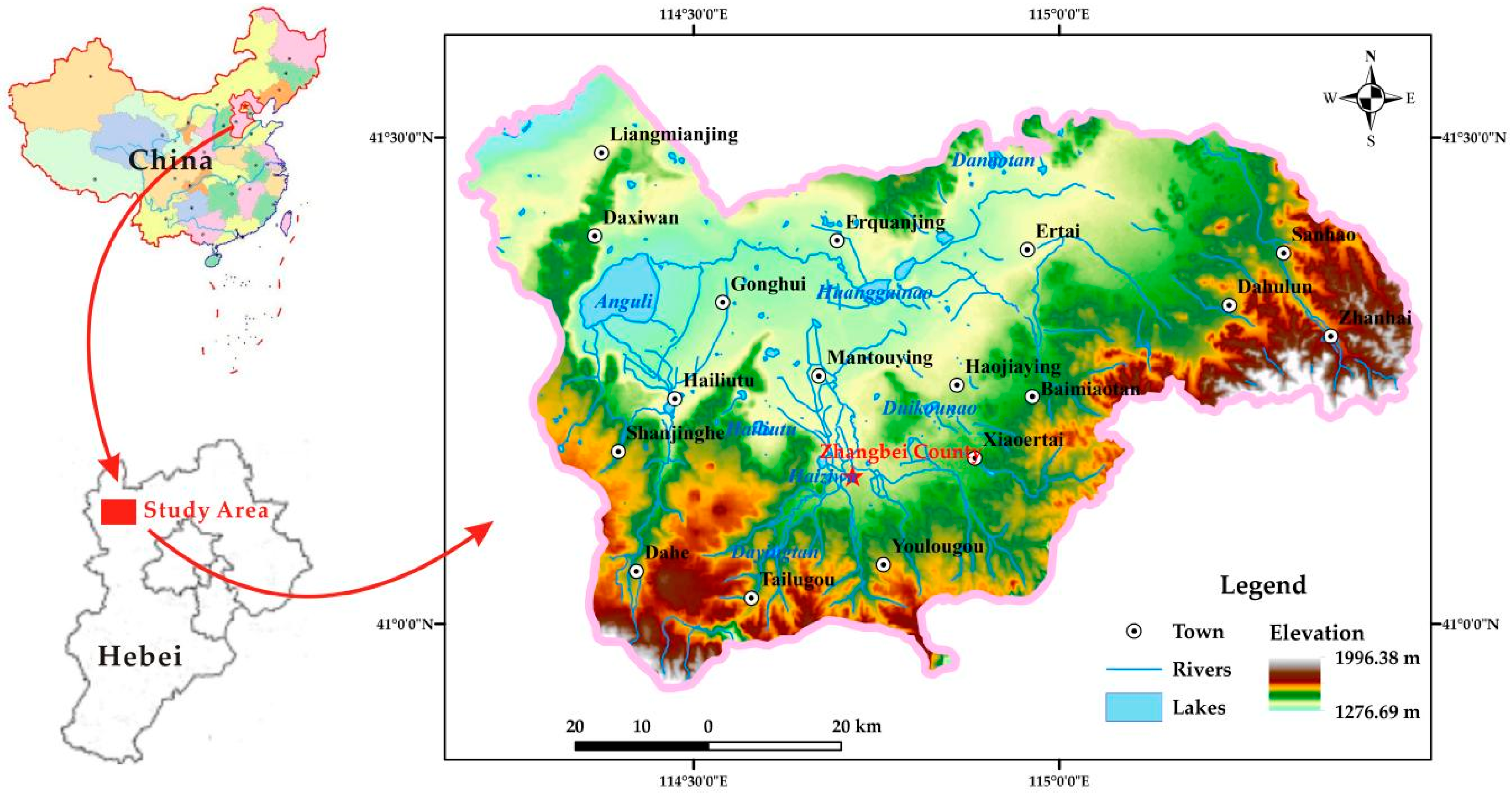
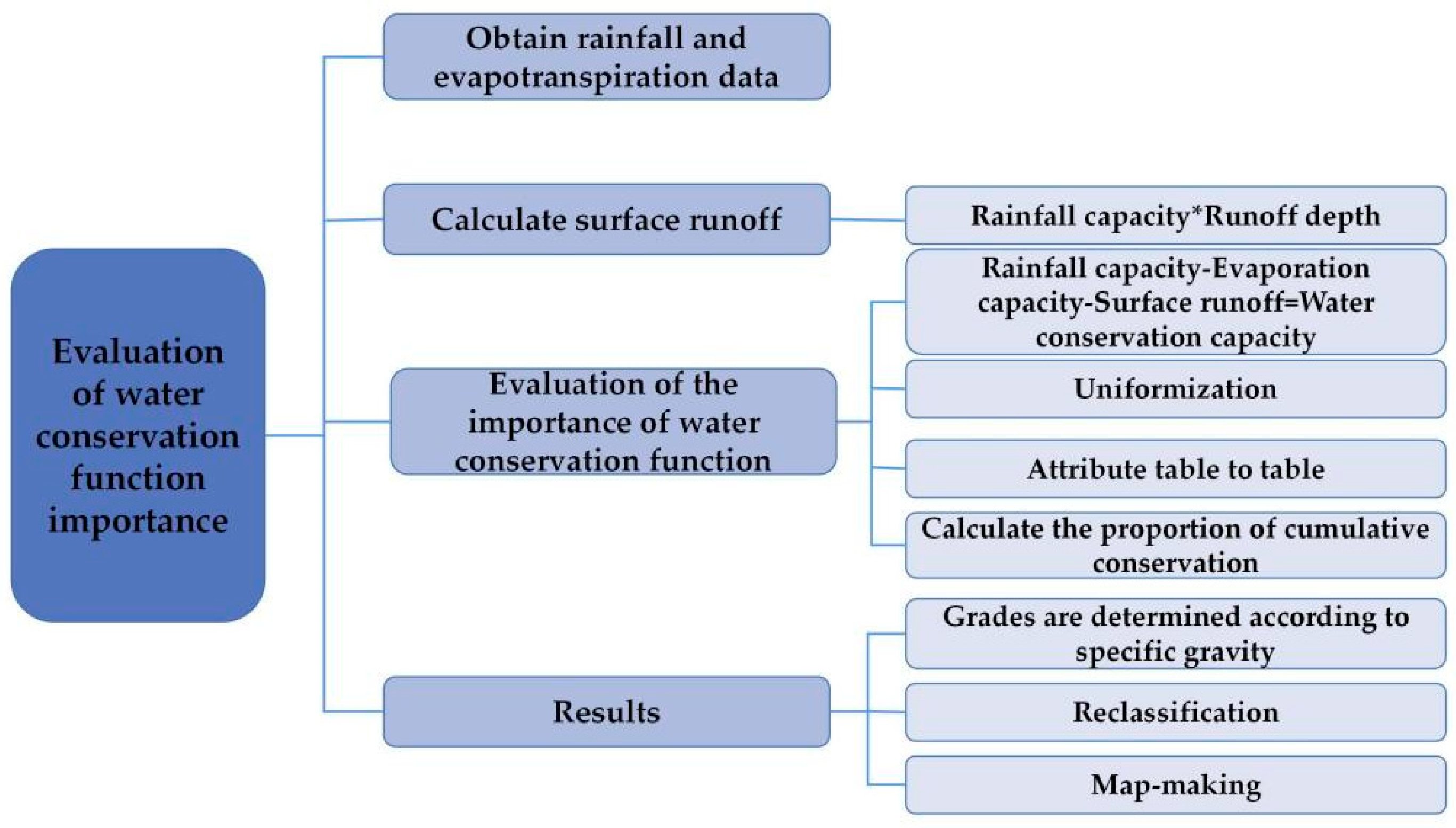
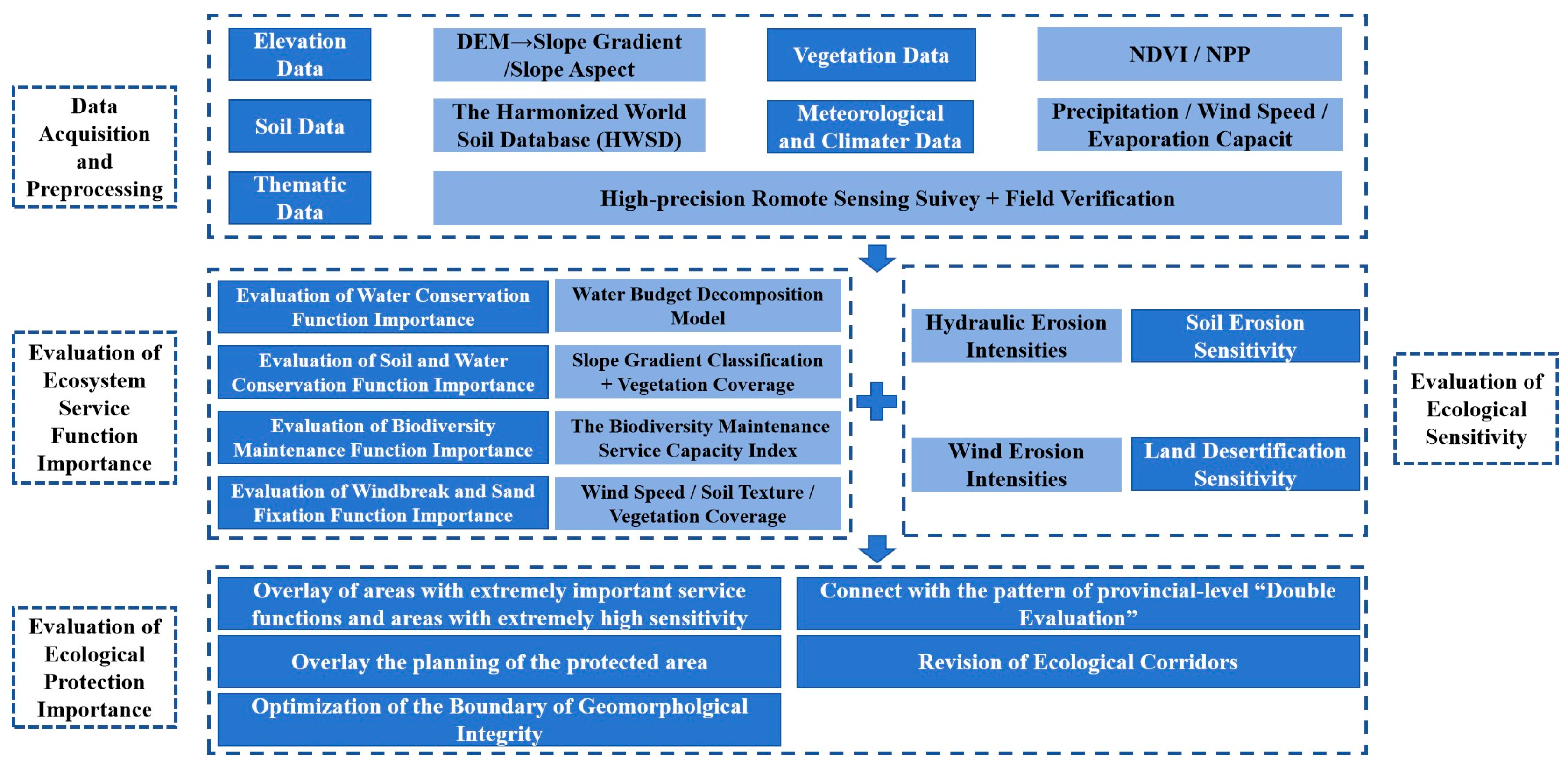
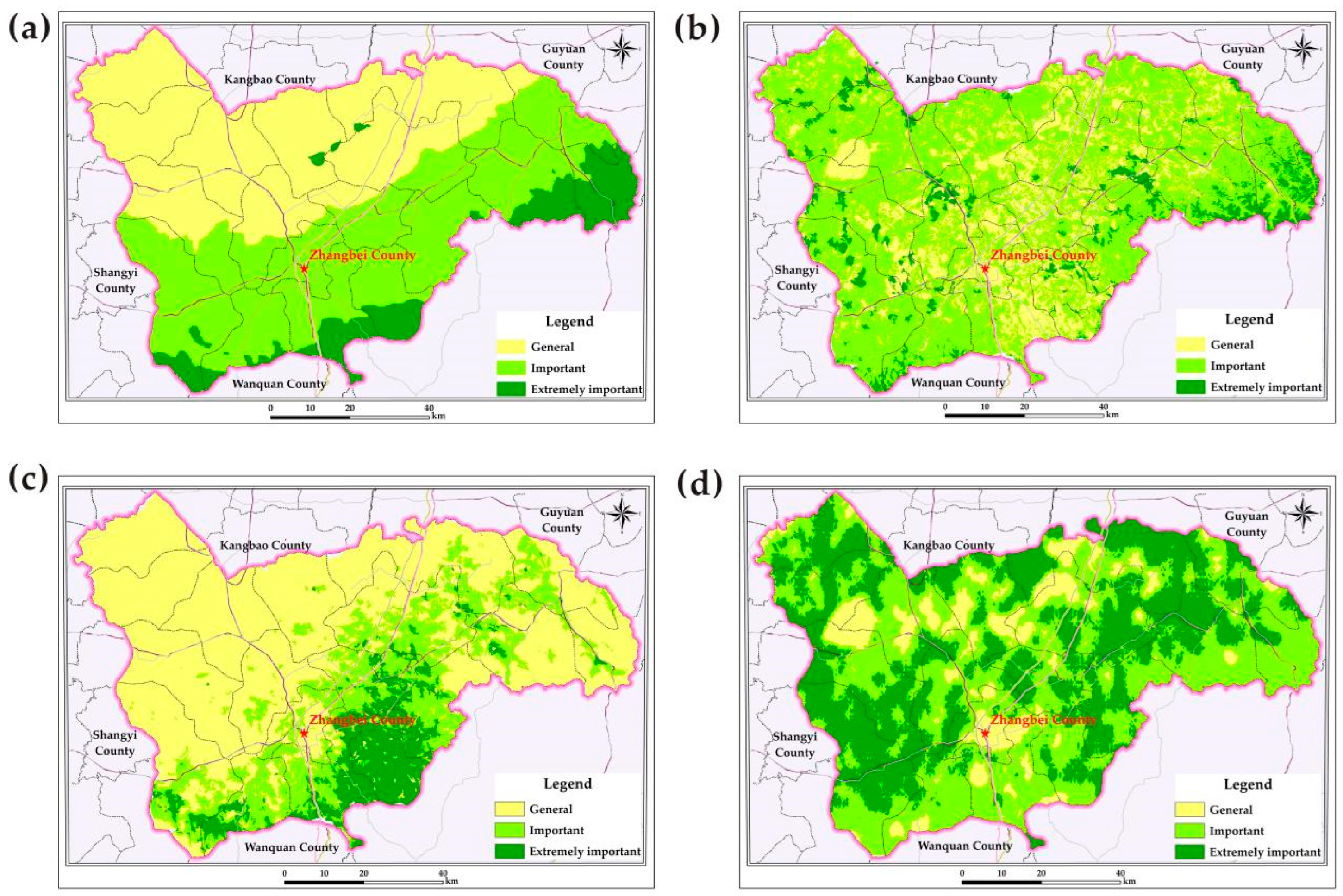
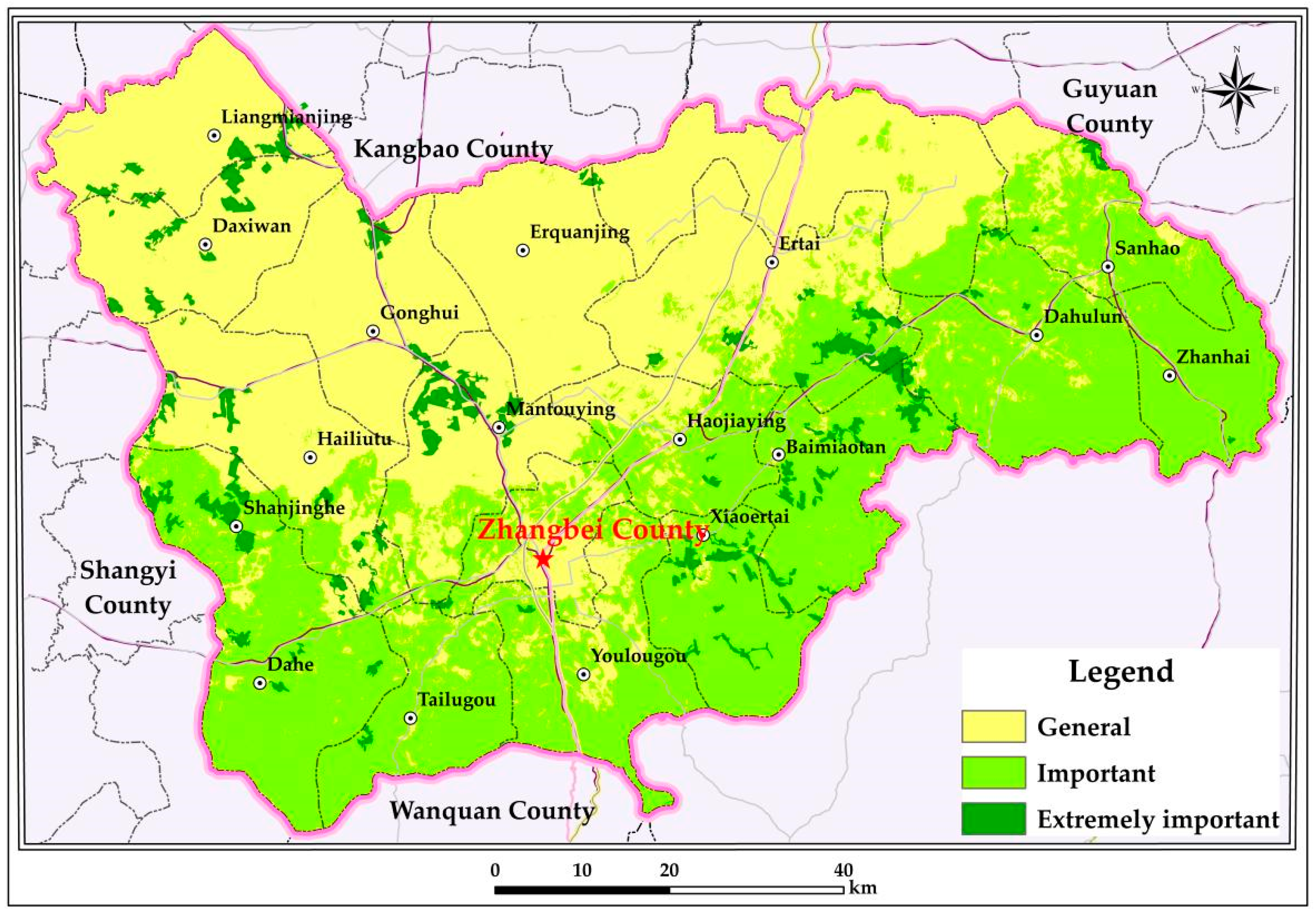
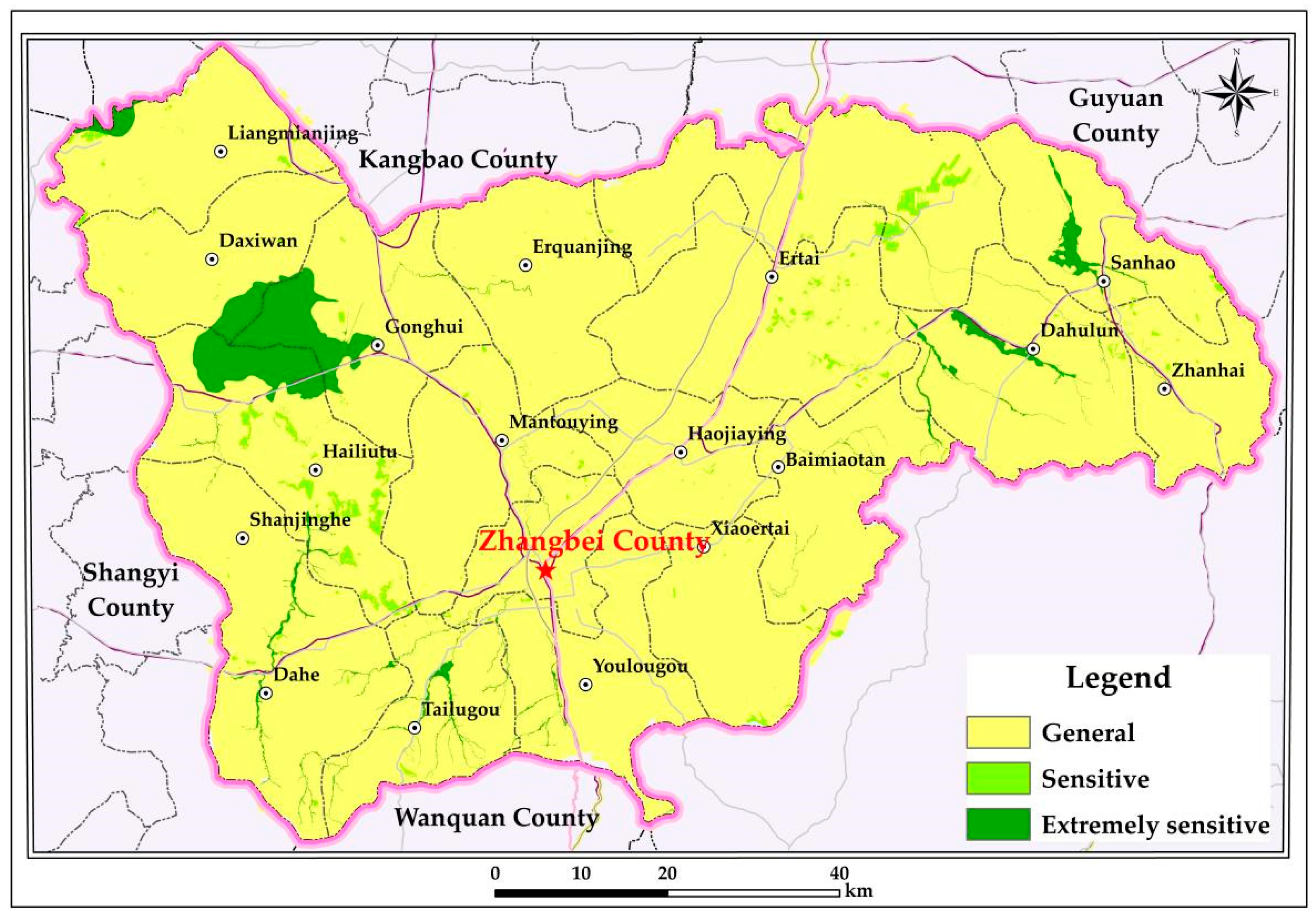
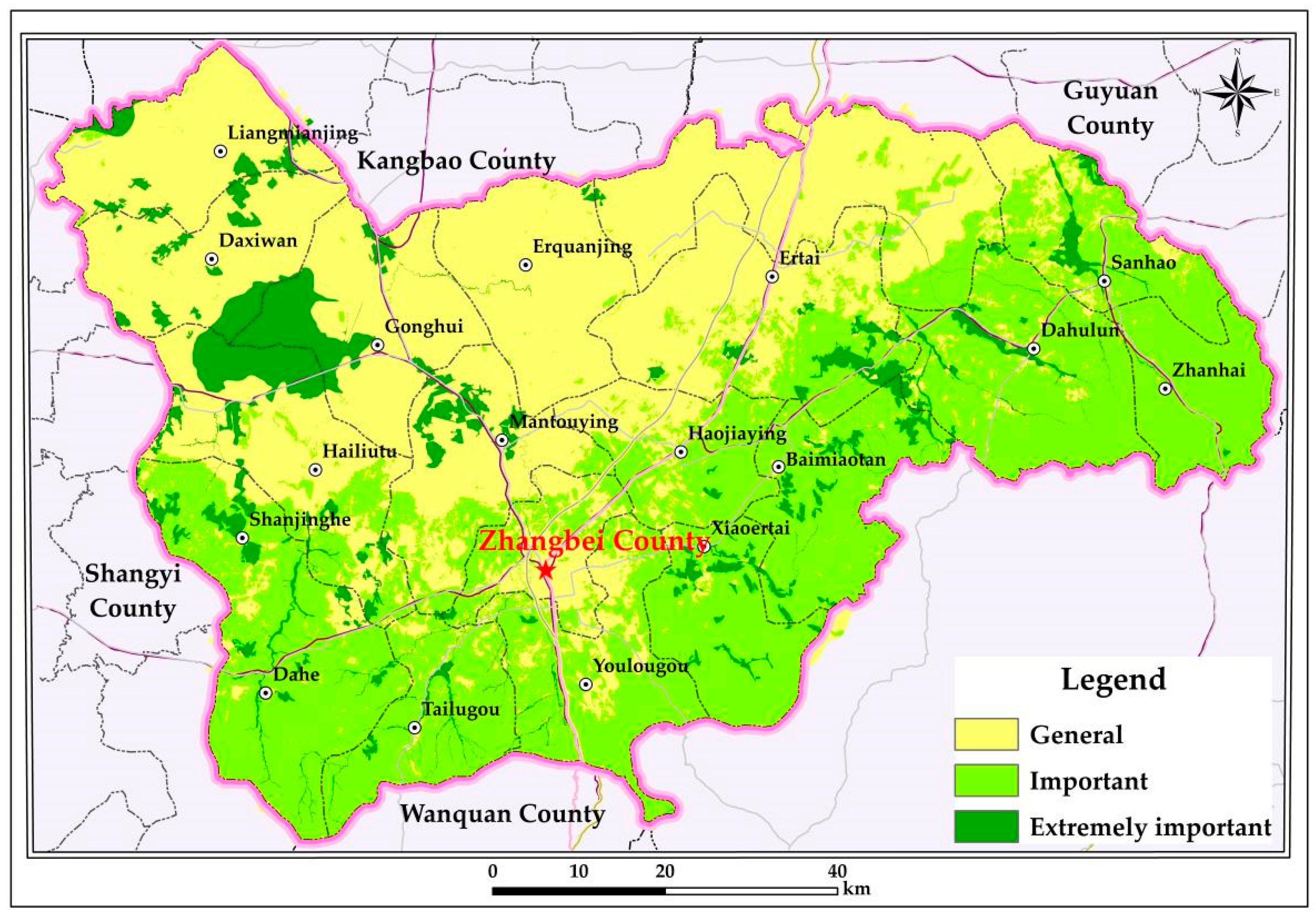
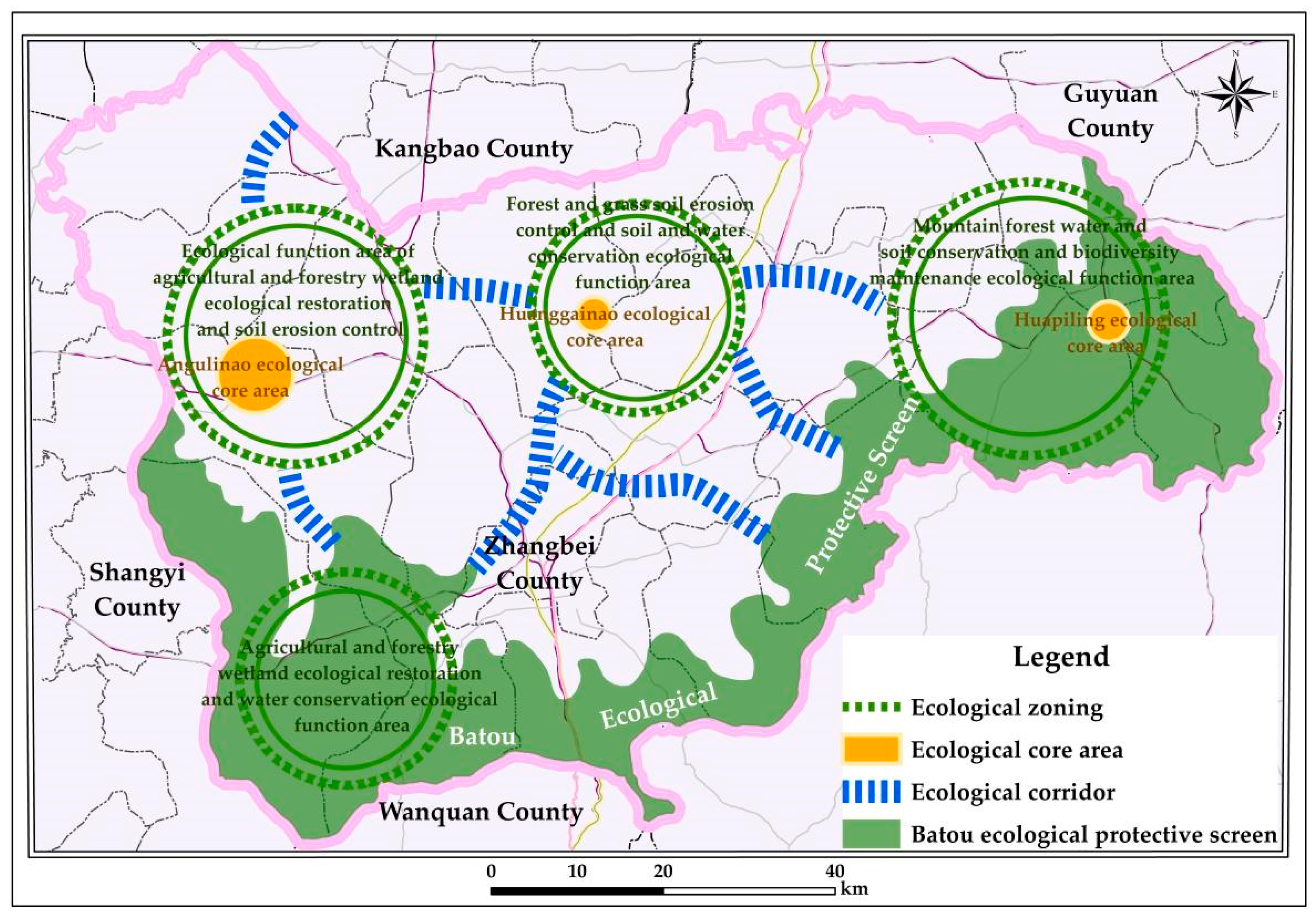
| Data | Description | Resolution Ratio/km | Data Sources |
|---|---|---|---|
| Elevation data set | DEM taster data | 0.03 | Geo-spatial data cloud |
| NDVI data set | Raster | 1 | MOSIS |
| NPP data set | Raster | 1 | GLASS dataset |
| Soil data set | Raster | 1 | Geo-graphic remote sensing ecological network platform |
| Meteorological and climate data sets | Raster/text | 1 | China meteorological science data |
| Slope Gradient | Forest, Scrub and Grassland Coverage More Than 60% | Forest, Scrub and Grassland Coverage Is 20–60% | Forest, Scrub and Grassland Cover Less Than 20% |
|---|---|---|---|
| Steep | 5 | 3 | 1 |
| Relatively steep | 3 | 3 | 1 |
| Gradual | 1 | 1 | 1 |
| Function | Extremely Important | Important | Generally Important | |||
|---|---|---|---|---|---|---|
| Area (km2) | Proportion (%) | Area (km2) | Proportion (%) | Area (km2) | Proportion (%) | |
| Water conservation | 445.53 | 10.31 | 1951.45 | 45.17 | 1923.71 | 44.52 |
| Soil and water conservation | 302.86 | 7.01 | 2957.12 | 68.44 | 1060.71 | 24.55 |
| Biodiversity maintenance | 495.72 | 11.47 | 1004.93 | 23.26 | 2820.04 | 65.27 |
| Windbreak and sand fixation | 1753.13 | 40.58 | 2067.67 | 47.85 | 499.89 | 11.57 |
| Function | Extremely Important | Important | Generally Important | |||
|---|---|---|---|---|---|---|
| Area (km2) | Proportion (%) | Area (km2) | Proportion (%) | Area (km2) | Proportion (%) | |
| Ecosystem service function | 203.69 | 4.71 | 1970.77 | 45.61 | 2146.23 | 49.67 |
| Function | Highly Sensitive | Sensitive | Moderate | |||
|---|---|---|---|---|---|---|
| Area (km2) | Proportion (%) | Area (km2) | Proportion (%) | Area (km2) | Proportion (%) | |
| Ecological sensitivity | 179.44 | 4.15 | 77.91 | 1.80 | 4063.34 | 94.04 |
| Function | Extremely Important | Important | Generally Important | |||
|---|---|---|---|---|---|---|
| Area (km2) | Proportion (%) | Area (km2) | Proportion (%) | Area (km2) | Proportion (%) | |
| Ecological protection | 333.04 | 7.71 | 1943.86 | 44.99 | 2043.79 | 47.30 |
Disclaimer/Publisher’s Note: The statements, opinions and data contained in all publications are solely those of the individual author(s) and contributor(s) and not of MDPI and/or the editor(s). MDPI and/or the editor(s) disclaim responsibility for any injury to people or property resulting from any ideas, methods, instructions or products referred to in the content. |
© 2025 by the authors. Licensee MDPI, Basel, Switzerland. This article is an open access article distributed under the terms and conditions of the Creative Commons Attribution (CC BY) license (https://creativecommons.org/licenses/by/4.0/).
Share and Cite
Miao, J.-J.; Gao, Y.-H.; Zhang, Y.; Gao, X.-S.; Xu, D.-H.; Yang, J.-Q.; Wang, W.; Liu, H.-W. Suitability Evaluation of Ecological Restoration Relying on Water Resources in an Agro-Pastoral Transition Zone: A Case Study of Zhangbei, Zhangjiakou, Northern China. Water 2025, 17, 1393. https://doi.org/10.3390/w17091393
Miao J-J, Gao Y-H, Zhang Y, Gao X-S, Xu D-H, Yang J-Q, Wang W, Liu H-W. Suitability Evaluation of Ecological Restoration Relying on Water Resources in an Agro-Pastoral Transition Zone: A Case Study of Zhangbei, Zhangjiakou, Northern China. Water. 2025; 17(9):1393. https://doi.org/10.3390/w17091393
Chicago/Turabian StyleMiao, Jin-Jie, Yi-Hang Gao, Ying Zhang, Xue-Sheng Gao, Dan-Hong Xu, Jun-Quan Yang, Wei Wang, and Hong-Wei Liu. 2025. "Suitability Evaluation of Ecological Restoration Relying on Water Resources in an Agro-Pastoral Transition Zone: A Case Study of Zhangbei, Zhangjiakou, Northern China" Water 17, no. 9: 1393. https://doi.org/10.3390/w17091393
APA StyleMiao, J.-J., Gao, Y.-H., Zhang, Y., Gao, X.-S., Xu, D.-H., Yang, J.-Q., Wang, W., & Liu, H.-W. (2025). Suitability Evaluation of Ecological Restoration Relying on Water Resources in an Agro-Pastoral Transition Zone: A Case Study of Zhangbei, Zhangjiakou, Northern China. Water, 17(9), 1393. https://doi.org/10.3390/w17091393





